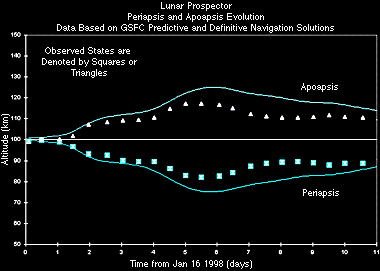
K3PGP Experimenter's Corner
Lunar Prospector Mission Status Report #17
February 06, 1998 - 6:00 pm EST (3:00 a.m. PST)
As discussed in previous status reports, Lunar Prospector scientists require orbit ephemeris data that describe the position of the spacecraft over the moon in order to accurately map data collected by their instruments onto the lunar surface. An accurate history of the Lunar Prospector trajectory over the moon is referred to as a "definitive" orbit ephemeris. A prediction of the future path of the spacecraft is referred to as a "predicted" orbit ephemeris. For Lunar Prospector, engineers at NASA's Goddard Space Flight Center use Doppler data collected by tracking stations from the Jet Propulsion Laboratory's (JPL) Deep Space Network to compute a definitive orbit ephemeris. Predicted orbit ephemeredes are also generated for several weeks into the future in order to enable mission controllers to schedule station tracks, anticipate shadow events and plan orbit maneuvers as necessary. Long-term predictions of the path of low altitude lunar orbiting missions is made difficult by the moon's non-uniform gravity field that results from an uneven distribution of the moon's mass. The non-uniform mass distribution of the moon makes it necessary to construct complicated models of the lunar gravity in order to accurately predict the evolution of the LP orbit over time. The figure above shows predictions made shortly after entering the mapping orbit of the periapsis (lowest) and apoapsis (highest) altitude of Lunar Prospector compared with actual values computed from a definitive orbit. Such figures are used to assess the accuracy of candidate lunar gravity models
The Doppler Gravity Experiment (see description under the "Instrument" heading of the LP Web site's Science section) conducted by Dr. Alexander Konopliv of JPL, will among other things, help construct an improved gravity model of the moon which can be used by this and future missions to compute accurate long-term orbit predictions. Until now, very few missions have orbited the moon close enough and long enough to allow a highly accurate lunar gravity model to be constructed. Lunar Prospector is unique, in that it will orbit the moon in a low polar orbit (dropping as low as 10 km during the extended mission) that will provide gravity data over the entire lunar surface every two weeks. Already, preliminary gravity models from the Doppler Gravity Experiment are being generated which appear to be tracking definitive solutions much more closely than the sample pre-launch model shown in the figure above.
Contents of this website are ©1997-98 of K3PGP and of the originating authors.